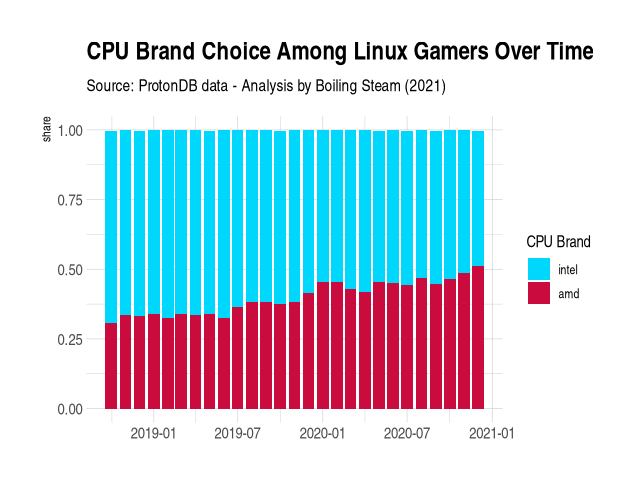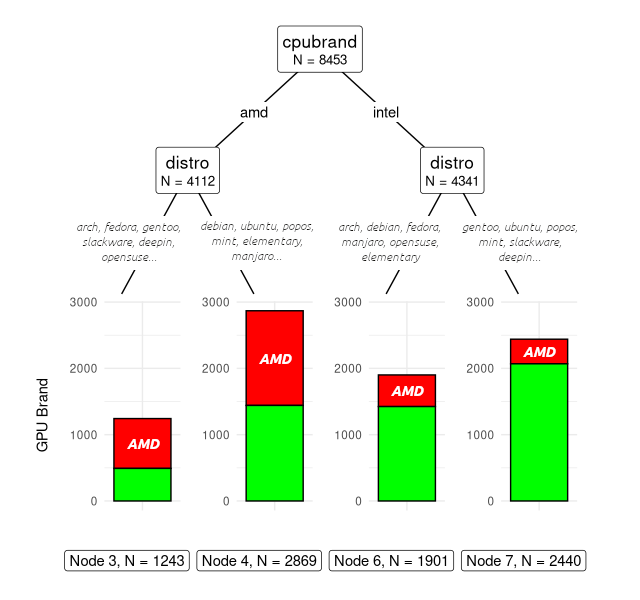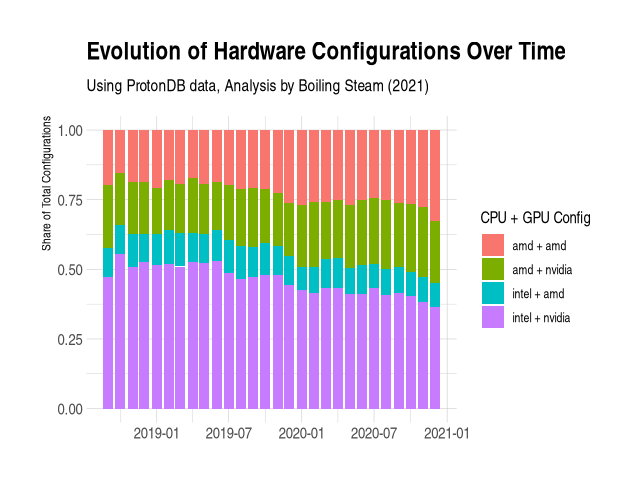AMD vs Nvidia: Are Linux Gamers Switching Yet?
Being part of the 1% market share, Linux users tend to be somewhat isolated. It makes it more difficult for all of us to actually get a good understanding of the dynamics at play in the market of hardware support and distributions. We typically have so few examples around us, and telemetry on various distributions is hardly reliable (non-existing or easily stopped). There are however some interesting patterns when it comes to hardware choices, as long as we can find some clues about them.
Fortunately for us, we have the wealth of data present in ProtonDB to check things out. While it is primarily used for game reports across configurations, it can be used in many other ways, such as looking at the combination of hardware and software out there.
There’s also the Steam Hardware survey, but it’s mostly useless as it lacks granularity to understand every user’s type of config. It’s only useful to see very large trends, or to make nonsensical clickbait titles about the evolution of the Linux market share, every time it shifts 0.1% up or down. As if it really mattered.
Let’s nevertheless take a bird’s eye view about the hardware trends among Linux gamers. Disclaimer first: this is the best data that what we have right now, having a single source is probably not ideal. But, short of doing large scale surveys among a larger population of Linux Gamers, this is what we are working with.
On the CPU side, AMD is completely killing it.

In the span of about 2 years, they managed to take a huge chunk of the share of the Linux gamers’ market. Among ProtonDB contributors, almost half of them now run on an AMD CPU-based configuration. This is driven by the great progress that AMD has made, by mostly matching single-core performance and providing a lot more cores for a better value than Intel CPUs. This is likely to continue in the near future as Intel has difficulty catching up for now.
On the GPU side of things, AMD is making some progress, but it’s a LOT less noticeable.

They are progressively eroding the share of Nvidia among Linux gamers, but by far and large Nvidia owners are still the majority. There are more and more reasons nowadays to prefer AMD on Linux, with a more open graphic stack (using Mesa), proper Wayland support, and better VR support (async reprojection). Only AMD makes it possible to play Cyberpunk 2077 properly so far, so this has to count for something as well.
Nvidia is however a far more formidable opponent than Intel on the CPU category, and they often innovate ahead of AMD, with raytracing, DLSS and so on. I might add that while Nvidia is often reviled for its GPU drivers being proprietary, they are still excellent drivers nonetheless. Nvidia would be unable to capture such a large market share over time if they had subpar products, whether in software or hardware.
Now, the more interesting analysis comes next. If we look at the combination of distros, CPU brand and GPU brands, are there any obvious patterns?
The answer is a resounding YES.

- If you own an Intel CPU, you are far, far more likely to have a Nvidia GPU as well.
- If you own an AMD CPU, there’s a good chance (50/50) you have an AMD GPU as well, and even more so if you use very specific distros (Arch, Gentoo, Slack, KdeNeon, Fedora, Deepin, Void…)
We are talking about statistically significant differences, by the way (p < 0.001).
Well, let’s first start with the fact that on Linux, if you were ever interested in gaming with decent performance, an Intel + Nvidia combo was pretty much required until fairly recently. Intel, for the best single thread performance on CPUs, and Nvidia both for their excellent proprietary drivers and better hardware/pricing overall (and no competition at the very high end). Things have been progressively changing, and AMD has now become a reasonable choice in both areas: a powerhouse for CPUs with numerous cores, and competitive on the low to medium range of GPU cards. On Linux, most AMD enthusiasts have probably started by adopting CPUs for quite a while since they fared better for parallel workloads - and now AMD is even catching up on single-thread performance with their latest processors.
The Arch-based distros actually have a bias towards AMD rather than Nvidia. Of course, Nvidia is still the majority, but there’s definitely a difference between AMD and Nvidia if you compare Arch and Ubuntu. This comes down to support. On Ubuntu, it’s easy to get the latest drivers for Nvidia: it’s just a PPA away. However, for AMD, you not only need the latest Mesa drivers (which is also fairly easy to get) but also the latest kernel to secure the best hardware support. Changing to newer kernels on Ubuntu is typically unsupported (it’s possible, but Ubuntu does not recommend it) and sometimes risky while it’s the de-facto everyday situation on Arch (unless you’re using the LTS kernels).
Now, why is there a connection between AMD CPUs and AMD GPUs? There is no technical reason why such a preference might exist. An AMD GPU will perform the same regardless of the CPU you use. This is where the shift in mindset is probably the most relevant. End users went first for AMD as they were almost unbeatable for price and performance in CPUs, and their positive experience may have had a halo effect on their next choice of hardware when it came to renewing their GPU. Another explanation could be that if you switched to AMD after decades of using Intel, you may be more “open minded” to try out other brands when the choice is available, while Intel CPU users may be slower to consider alternatives, or less interested to find out about AMD if they are already satisfied with their configuration. It’s probably something with multiple factors that would be worth exploring further.
There is something new happening at AMD however. In 2020, AMD has announced that they are developing a technology to benefit users who have a combination of AMD CPU and AMD GPU - Smart Access Memory. This would be a pool of shared memory that both the GPU and CPU could use, leading to simpler memory management and higher data transfer rates between the CPU and GPU. For now this is going to be limited to configurations having a Radeon RX 6000 GPU (all models), at least a Ryzen 5000 processor, and a standard 500-series motherboard. AMD is in a unique position to achieve such improvements, as Nvidia cannot produce x86 chips and Intel is mostly out of the discrete graphics card business.
On Linux, the Smart Access Memory used to be available on a wider range of configurations via Mesa, but a recent update restricts it to more modern hardware just like on Windows, because of instabilities on older hardware apparently. This being said, that’s one thing we can consider to be “feature parity” with Windows, which is good in the world of GPU support.
Looking at now how the various combinations of cpu and gpu vendors have evolved over time within the realm of the ProtonDB data, we get the following:

It is absolutely shocking how fast the combination of “Intel + Nvidia” has dropped in the span of 2 years. As we have seen, it’s not so much that Nvidia has lost market share, it’s rather the fact that most previous Intel users have switched to AMD the next time they wanted to renew their hardware. And on the other end, while still a minority, the fastest growing configuration type is “amd cpu + amd gpu” - and this is explained by several factors as discussed above.
As for me, I am still on Intel / Nvidia. I almost switched to an AMD CPU a year and a half ago, but locally they were running out of stock and prices were going up. I am convinced that Ryzen is the way to go for CPUs in the future, while I am not yet on board with switching to AMD when it comes to GPUs. As far as drivers are concerned on Linux, Nvidia remains an excellent choice (while fully proprietary) and their hardware is still ahead in the mid-high range, at least until very recently. AMD is now very close to matching Nvidia also in the higher end. And if you ever care about VR, AMD is definitely the way to go right now.
But we are in 2021, and GPU shortage has become the norm. Even mid-range cards are pretty much unavailable to purchase whether it’s Nvidia or AMD. This may prevent the market from switching drastically in one way or another any time soon.
So this is the observations we can make from the ProtonDB data. Now, it’s probably biased in one way or another, and this is why we are going to conduct again a Linux Gamers survey in the near future to hopefully get another sample to see with a new pair of eyes if these trends are really out there.
